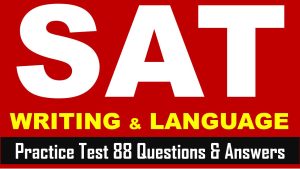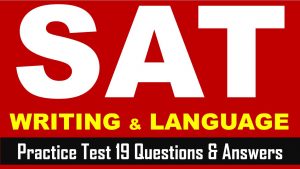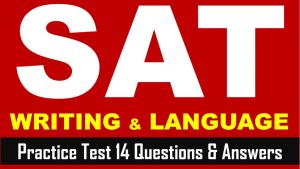Hi SAT Aspirants, welcome to AKVTutorials. As you know SAT (Scholastic Assessment Test) is a standard test, used for taking admission to undergraduate programs of universities or colleges of United States. SAT is developed and published by the College Board, an organization in United States, administered by the Educational Testing Service. Therefore, you need to do practice on SAT Reading Section, SAT Writing and Language Section. In this article, you will get SAT Writing Practice Test 33 with Answer Keys AMBIPi
Instruction:
- In the passage below is accompanied by a number of questions.
- For some questions, you need to think how the passage might be revised to improve the expression of ideas.
- For other questions, you will consider how the passage might be edited to correct errors in sentence structure, usage, or punctuation.
- Some questions will direct you to an underlined portion of a passage.
- Other questions will direct you to a location in a passage or ask you to think about the passage as a whole.
SAT Writing & Language Section Passage
SAT Writing Passage Title: The Architecture of castle
The castles of fairy tales, with their high, narrow towers, gargoyles, and spires, are more the reflections of nineteenth-century ideas than of the great stone fortresses of the middle ages. 1 Regardless, the architecture of medieval castles centered on one main 2 principle defense.
A wealthy lord would typically build a castle on a defensible 3 site, such as a hill or large rock or even a high crag. A deep ditch called a moat would be dug around the perimeter. Drawbridges typically would provide the only way across the moat so that it could easily be pulled up to prevent enemy access.
[1] The strongest castles were made with stone walls around eight to twelve feet thick. [2] An outer wall of about twenty feet in height would surround an inner 4 wall; where the castle occupants actually lived. [3] Keeping it lower than the inner wall allowed archers to shoot from the inner wall over the men on the outside. [4] The outer wall was the next line of defense after the moat and drawbridge. [5] Archers aimed through vertical slits in the walls called arrow loops, which 5 were often cut in the shape of a cross. 6
The gates of castles 7 constituted the greatest weak points. To compensate, a heavy sliding grate called a portcullis would be installed to close vertically over the 8 gateway. What followed next were heavy doors barred from behind with a thick wooden beam. In the tunnel-like space between the portcullis and the 9 doors, and openings in the arched ceiling called “murder holes” enabled defending soldiers to drop heavy objects onto attackers.
Large windows in residential housing were necessary to allow enough light. Apartments and large rooms for gathering, like the great hall and the chapel, were built on the upper levels of the inner walls because 10 the threat presented by their large windows was too perilous.
The farmers and tradesmen who lived in the town surrounding a castle provided food and goods for the wealthy lord, his family and staff, and his militia. They in turn received shelter and sustenance. But ultimately, the castle existed more for his defense than 11 they’re protection.
SAT Writing & Language Practice Questions
Question No 1
Which choice best maintains the sentence pattern already established in the paragraph?
Option A : No Change
Option B : Furthermore,
Option C : Hence,
Option D : In reality,
Answer
Show/Hide Answer
Option D : In reality,
because the first sentence brings up fairy tale depictions of castles. The second sentence describes what they’re like in reality.
Question No 2
Which of the following options is the most effective?
Option A : No Change
Option B : principle,
Option C : principle:
Option D : principle;
Answer
Show/Hide Answer
Option C : principle:
because the sentence leads into defense being the main principle. The other answer choices lead to grammatically incorrect sentences.
Question No 3
Which choice provides the most effectively transition to the information that follows?
Option A : No Change
Option B : site such as:
Option C : site such as,
Option D : site, such as,
Answer
Show/Hide Answer
Option A : No Change
because there is no punctuation needed after such as.
Question No 4
Which choice results in the most effective transition to the information that follows in the paragraph?
Option A : No Change
Option B : wall, which
Option C : wall, during which
Option D : wall, within which
Answer
Show/Hide Answer
Option D : wall, within which
because answers A and B are grammatically incorrect. Answer C is nonsensical because during refers to a time. Here, we’re discussing a wall.
Question No 5
Which choice results in a sentence that best supports the point developed in this paragraph
Option A : No Change
Option B : were not introduced until 212 BC.
Option C : allowed them to fire upon enemies while remaining protected.
Option D : were invented by Archimedes and popularized by the Greeks and Romans.
Answer
Show/Hide Answer
Option C : allowed them to fire upon enemies while remaining protected.
because The paragraph’s main purpose is to support the point that a castle’s design is based on defense. Answer C best supports that point.
Question No 6
Which choice best maintains the sentence pattern already established in the paragraph?
Option A : placed where it is now.
Option B : placed after sentence 1.
Option C : placed after sentence 4.
Option D : placed after sentence 5.
Answer
Show/Hide Answer
Option C : placed after sentence 4.
because it explains how the outer wall was the next line of defense. Furthermore, the discussion of archers would then continue nicely into sentence 5. While it may seem like sentence 3 is fine after sentence 2, that placement would make sentence 4 seem misplaced and break up the discussion about archers.
Question No 7
Which choice best maintains the sentence pattern already established in the paragraph?
Option A : No Change
Option B : composed
Option C : comprehended
Option D : circumscribed
Answer
Show/Hide Answer
Option A : No Change
because A Constitute means to make up or form. The other answer choices are nonsensical.
Question No 8
The writer is considering deleting the underlined sentence. Should the sentence be kept or deleted?
Option A : NO CHANGE
Option B : gateway, followed by
Option C : gateway follow
Option D : gateway by following
Answer
Show/Hide Answer
Option B : gateway, followed by
because Answer A is passive and wordy. Answer C introduces a double-verb, which is nonsensical. Answer D changes the meaning of the sentence to something nonsensical.
Question No 9
Which choice best maintains the sentence pattern already established in the paragraph?
Option A : No Change
Option B : doors,
Option C : doors with
Option D : doors were
Answer
Show/Hide Answer
Option B : doors,
because The first part of the sentence is a nonessential phrase that should be set off by just commas and nothing more. Answer C leads to a long sentence fragment. Answer D results in a double-verb.
Question No 10
Which choice best maintains the sentence pattern already established in the paragraph?
Option A : No Change
Option B : a danger to safety was caused by their large windows.
Option C : their large windows endangered people to harm.
Option D : their large windows posed a security risk.
Answer
Show/Hide Answer
Option D : their large windows posed a security risk.
because Answer D is the most concise. The other answer choices are wordy and redundant.
Question No 11
Which choice completes the sentence with accurate data based on the graph?
Option A : No Change
Option B : for their
Option C : for there
Option D : to their
Answer
Show/Hide Answer
Option B: for their
because We need the plural possessive their to refer to the farmers and tradesmen. The correct preposition is for to maintain the parallelism.



